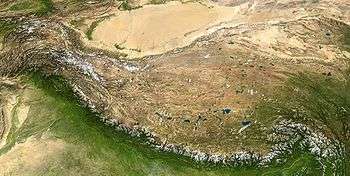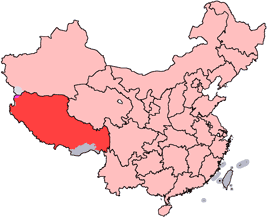Outline of Tibet


The following outline is provided as an overview of and topical guide to Tibet:
Tibet is a plateau region in Asia and the home to the indigenous Tibetan people. With an average elevation of 4,900 metres (16,000 ft), it is the highest region on Earth and is commonly referred to as the "Roof of the World."
A unified Tibet first came into being under Songtsän Gampo in the 7th century. From the early 17th century until the 1959 uprising, the Dalai Lamas (Tibetan Buddhist spiritual leaders) were, at least nominally,[1] heads of a centralised Tibetan administration, with political power to administer religious and administrative authority[1] over large parts of Tibet from the traditional capital Lhasa. They are believed to be the emanations of Avalokiteśvara (or "Chenrezig" [spyan ras gzigs] in Tibetan), the bodhisattva of compassion.
General reference
- Pronunciation:
- Common English country names: Tibet; or Xizang
- Official English country names: Tibet; or the Xizang Autonomous Region of the People's Republic of China
- Common endonym(s):
- Official endonym(s):
- Adjectival(s): Tibetan
- Demonym(s): Tibetans
- Etymology: Name of Tibet
- ISO region code for Xizang: CN-54
Geography of Tibet

- Location:
- Northern Hemisphere and Eastern Hemisphere
- Eurasia
- Time zone: China Standard Time (UTC+08)
- Extreme points of Tibet
- High: Mount Everest 8,848 m (29,029 ft) – highest point on Earth
- Low: Yarlung Tsangpo 1,615 m (5,299 ft)
- Population of Tibet:
- Area of Tibet:
- Demographics of Tibet
- Atlas of Tibet
Environment of Tibet
- Climate
- Flora (plants of Tibet)
- Lichens
- Grasses
- Ampelocissus xizangensis
- Anisodus tanguticus
- Aralia tibetana
- Borinda
- Buddleja crispa var. tibetica
- Buddleja forrestii
- Cedrus deodara
- Cupressus gigantea
- Cupressus torulosa
- Fallopia baldschuanica
- Incarvillea
- Juniperus indica
- Juniperus tibetica
- Luculia gratissima
- Paeonia lactiflora
- Parapteropyrum
- Russian sage
- Noble rhubarb
- Salvia castanea
- Salvia wardii
- Spikenard
- Tetrapanax tibetanus
- Tibetan elm
- Siberian elm
- Utricularia salwinensis
- Fauna
Geographic features of Tibet
- Tibetan Plateau
- Surrounding mountains:
- Lake Region (Changtang):
- River region:
- Yellow River
- Yangtze River
- Yalong River
- Salween River (Nu)
- Mekong (Lancang)
- Indus River
- Sutlej
- South Tibet Valley:
Administrative divisions of Tibet
Administrative divisions of Tibet
Tibet is divided into 7 prefecture-level divisions, 73 county-level divisions, and 692 township-level divisions. The 7 prefecture-level divisions are:
- Lhasa City
- Nagchu Prefecture
- Chamdo Prefecture
- Nyingtri Prefecture
- Shannan Prefecture
- Shigatse Prefecture
- Ngari Prefecture
There are also three traditional provinces or regions of Tibet:
Government and politics of Tibet
- Form of government: Autonomous areas of China; Government in exile
- Capital of Tibet: Lhasa
- Elections in Tibet
Branches of the government of Tibet
Executive branch of the government of Tibet
- Chairman of the Tibet Autonomous Region: Padma Choling
- Local Communist Party secretary: Zhang Qingli
Legislative branch of the government of Tibet
- Tibetan Regional Congress Standing Committee (unicameral)
Foreign relations of Tibet
International organization membership
- none [2]
Law and order in Tibet
- Constitution of Tibet
- Crime in Tibet
- Law enforcement in Tibet
- Human rights in Tibet
Government in exile
History of Tibet
- Main articles: History of Tibet and Timeline of Tibetan history
- List of rulers of Tibet
- Neolithic Tibet
- Zhangzhung
- Pre-Imperial Tibet
- Tibetan Empire
- Sino-Tibetan relations during the Tang dynasty
- Era of Fragmentation
- Guge
- Mongol conquest of Tibet
- Tibet under Yuan rule
- Phagmodrupa Dynasty
- Rinpungpa
- Tsangpa
- Sino-Tibetan relations during the Ming dynasty
- Ganden Phodrang
- Tibet under Qing rule
- History of European exploration in Tibet
- British expedition to Tibet
- Tibet (1912–51)
- History of Tibet (1950–present)
- Incorporation of Tibet into the People's Republic of China
- CIA Tibetan program
- Protests and uprisings in Tibet since 1950
Culture of Tibet
- Tibetan people
- Cuisine of Tibet
- Traditional Tibetan medicine
- Tibetan calendar
- Tibetan Festivals
- Public holidays
- Newspapers in Tibet
- Sport in Tibet
Religion in Tibet
Art in Tibet
- Tibetan art
- Contemporary Tibetan art
- Architecture in Tibet
- World Heritage Sites in Tibet:
- Tibetan-language films
- Tibetan Literature
- Music of Tibet
National symbols of Tibet
Economy and infrastructure of Tibet
- Currency: Renminbi Yuan (de facto)
- Education in Tibet
- Communications in Tibet
- Transport in Tibet
- Airports in Tibet
- Qingzang Railway
- Roads in Tibet
- Tibetan tourism
- Tibetan agriculture
- Tibetan industry
- Tibetan water resources
- Tibetan energy resources
- Tibetan mineral resources
See also
| Tibetan language edition of Wikipedia, the free encyclopedia |
| Chinese language edition of Wikipedia, the free encyclopedia |
- Index of Tibet-related articles
- List of international rankings
- List of Tibet-related topics
- Outline of Asia
- Outline of China
- Outline of geography
References
- 1 2 The historical status of the Dalai Lamas as actual rulers is disputed. A. Tom Grunfeld's The Making of Modern Tibet, p. 12: "Given the low life expectancy in Tibet it was not uncommon for incarnations to die before, or soon after, their ascendancy to power. This resulted in long periods of rule by advisers, or, in the ease of Dalai Lama, regents. As a measure of the power that regents must have wielded it is important to note that only three of the fourteen Dalai Lamas have actually ruled Tibet. From 1751 to 1960 regents ruled for 77 percent of the time"
- ↑ "China". The World Factbook. United States Central Intelligence Agency. July 8, 2009. Retrieved July 23, 2009.
External links
- Tibetan Studies Internet Resources
 Tibet travel guide from Wikivoyage
Tibet travel guide from Wikivoyage